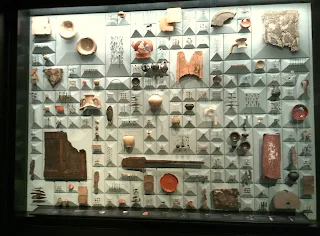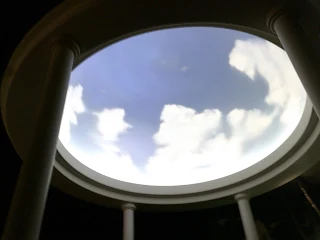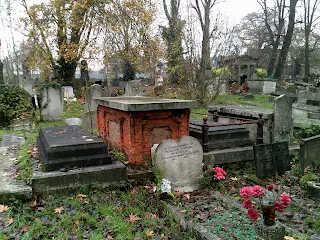I found out about the London Mithraeum after watching a TV programme, entitled Bacchus Uncovered: Ancient God Of Ecstasy, whilst lying on the sofa with the lurgy.
Bacchus was the Roman god of agriculture, wine and fertility. He was essentially copied from his Greek equivalent, Dionysus, but he is the pleasure god we modern people refer to when describing uninhibited or drunken revelry- as in bacchanalia.
Of course, such behaviour would appeal to a fun-loving, wine-supping creature such as myself!
The programme mentioned the Temple of Bacchus at Painshill Park, in Surrey, which is newly re-built and which I have visited...
At ground level inside the Walbrook building is this installation by Pablo Bronstein. It is called London in its Original Splendour (2018) and is an effective abstract collaboration of well-known London buildings.
You turn to this very simple but well-executed display wall of items uncovered from the site. There are accompanying tablets available, so that you can hone in on the details and history of individual pieces...
This wooden sign is believed to be the oldest piece of writing with London's given name on it...
Close-up of the wall...
Being a shoe fetishist, I just HAD to examine this Roman shoe...😉
She was an American lesbian who was involved with writer Natalie Barney. I like this painting as the subject's eyes draw you in and make you want to work out what's going on in her mind. She looks unhappy; bewildered, questioning, caught unawares and she appears to be enquiring as to why you're intruding by regarding her. Apparently, she had a very troubled childhood.
We had to finish the day with a Vain Old Tart photograph...
Number 12 Fournier Street...
I regard these two interesting gentlemen as my gay dads- we certainly share the same foul mouths! I've never understood what the big fuss is about swearing. Mind you, that comes from being brought up in a house where there was no such genteel thing as "The wrong end of the stick..." Oh no, my mother always called it, 'The shitty end of the stick...!'
😂😂😂😂
Bacchus was the Roman god of agriculture, wine and fertility. He was essentially copied from his Greek equivalent, Dionysus, but he is the pleasure god we modern people refer to when describing uninhibited or drunken revelry- as in bacchanalia.
Of course, such behaviour would appeal to a fun-loving, wine-supping creature such as myself!
The programme mentioned the Temple of Bacchus at Painshill Park, in Surrey, which is newly re-built and which I have visited...
...And brought to mind London's Roman Amphitheatre, which dates back to AD43, and which I also saw not too long ago...
...But I'd never heard of the London Mithraeum, which is in the vicinity of the above amphitheatre and free to visit as long as you book beforehand.
The temple site was uncovered between 1952 and 1954 and, as a compromise between re-designing the intended building- Bucklersbury House- and abandoning the historical site, the ruin was dismantled, re-assembled and moved 100 metres. The reconstruction was not accurate and the materials used drew criticism.
Following the demolition of Bucklersbury house, in 2007 the Bloomberg company purchased the Walbrook Square project and restored the Mithraeum to its original site, 7 metres below ground and just a few metres west of its original position. It opened in November 2017 and sits below the building which serves as Bloomberg's European headquarters.
This temple to the Roman god Mithras (or perhaps dedicated jointly with other deities favoured by Roman military men) was built in the 3rd century AD and lies on the site of the long-gone London river, the Walbrook.
The lost cult of Mithras first appeared in the 1st century AD and spread over Europe during the next 300 years, attracting the likes of imperial generals, soldiers and merchants. The temples- which were often constructed below ground- were dark, windowless and mysterious. The mythological scene of killing a bull within a cave- a tauroctony- was at the heart of this strictly male-only cult.
The cult was probably re-dedicated to Bacchus in the 4th century- hence its inclusion in that particular TV programme.
It was a drizzly and dank day when we emerged from Bank Tube station. Just around the corner from the Bloomberg building is this weird, green affair, which is sculpted from painted bronze. It is part of a trio of fountains by Spanish artist Cristina Inglesias and represents wellsprings and roots. The original river Walbrook is now part of the London sewer system.
At ground level inside the Walbrook building is this installation by Pablo Bronstein. It is called London in its Original Splendour (2018) and is an effective abstract collaboration of well-known London buildings.
You turn to this very simple but well-executed display wall of items uncovered from the site. There are accompanying tablets available, so that you can hone in on the details and history of individual pieces...
This wooden sign is believed to be the oldest piece of writing with London's given name on it...
Close-up of the wall...
Being a shoe fetishist, I just HAD to examine this Roman shoe...😉
You walk a floor down, to encounter this information (basically, what I've written about above...)
Then you enter this dark room with ghostly, informative stands and sculptures...
A few steps downstairs and you are now 7 metres below ground. This is the original situation of the Mithraeum- the Romans didn't live below ground; this was ground level in their day. Population and development mean that the ground level naturally rises.
Here is the Mithraeum plan...
The first part of the show is interactive, with low level light and the supposed sounds of a ritual meeting taking place two thousand years ago.
It is actually very realistic. Then the lights get brighter and you can walk around the Mithraeum and take pictures, albeit without a flash.
View from the back of the dais...
Plinth steps...
The glass floor as you enter...
These lights give the impression of spooky doors...
It's quite a good experience and certainly worth half an hour of your time.
We walked out and heard the sound of drums, as the procession of the annual Boar's Head Ceremony was arriving at Mansion House, home of the Lord Mayor of the City of London.
This dates back to 1343, when the monks living in the vicinity were tired of the local butchers depositing offal on the public highway. The butchers were granted a small patch of land for cleaning and preparing their meat, and the cost was that a pig's head had to be delivered to the Mayor of London every Christmas- forever.
The people in the fur trimmed robes are from the Worshipful Company of Butchers and a few hangers-on are joining in behind them. It was a real treat to run into this as I'd never even heard of it before. Nowadays, the boar's head is made of paper mache- the real thing having gone in before- and a feast takes place which includes the City's dignitaries. Riff-raff are certainly not invited!
This was a bit of a rushed photo, so it's not great...
We had a bit of time to kill so we made our way past St Paul's Cathedral...
...And into the Museum of London...
...Which has this quite picturesque 'sunken' (it's actually ground level, but we were now a level up, so it's illusory) garden...
I didn't really photograph much, as there's a lot to see and we wanted to have a simple stroll through. This space is also worth an hour of your time.
I did, though, have to take a picture of these restoration shoes...
This lovely pergola in the 'garden' feature reminded me of the Saloon in the Brighton Pavilion...
After the obligatory Pizza Express dinner (which included a nice glass of bacchanalian red...😉) we moved on to our Barbican exhibition, entitled Modern Couples. It explores creative relationships in art.
I couldn't take photos in here, but here's a PDF of the most evocative piece I saw.
Au Bord de la Mer (The Edge of the Sea), is a 1914 self-portrait by Romaine Brooks (1874-1970).She was an American lesbian who was involved with writer Natalie Barney. I like this painting as the subject's eyes draw you in and make you want to work out what's going on in her mind. She looks unhappy; bewildered, questioning, caught unawares and she appears to be enquiring as to why you're intruding by regarding her. Apparently, she had a very troubled childhood.
We had to finish the day with a Vain Old Tart photograph...
You'll be pleased to know that my trusty, favourite, eleven-year-old pink sparkly cardi finally died a death and had its funeral in the bin...😢
We went back to the exhibition a couple of weeks later, as our particular tickets allowed us to do so. After another pizza meal (this time at Pizza Union) I took a couple of photos of the Barbican complex. I love its Brutalist architecture but I do think the whole place reminds me of a council estate. Apparently, this Utopian estate was never that, but it sprang up from an area devastated by Second World War bomb damage into flats which were designed to be rent subsidised for essential workers.
Personally, I'm a real urban girl and I love it!
St Giles' Cripplegate Church. Many moons ago, I had a keen semi-professional photographer boyfriend who attended a monthly photo club in the basement. It is thought that there has been a church on this site for one thousand years.
Before this visit, I took the time to wander up Fournier Street, in Spitalfields. Here, artists Gilbert & George own numbers 8 and 12. They live in one- number 12- and have restored their original home since 1968- number 8- to its 18th century splendour. They gained additional studio space by acquiring land that stretches across the back of number 10.
Number 8 Fournier Street...
Number 12 Fournier Street...
I regard these two interesting gentlemen as my gay dads- we certainly share the same foul mouths! I've never understood what the big fuss is about swearing. Mind you, that comes from being brought up in a house where there was no such genteel thing as "The wrong end of the stick..." Oh no, my mother always called it, 'The shitty end of the stick...!'
😂😂😂😂
TTFN
The Miss Elaineous
XXXXXXXXXXXXXXXXXXXXX
XXXXXXXXXXXXXXX
XXXXXXXXXX
X















































































